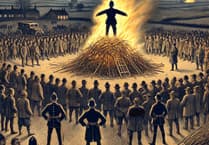On a chilly September night in 1786, an unknown sailor set foot in The Red Lion Inn at Thursley, seeking warmth and companionship. Little did he know, this would be his last stop before meeting a gruesome fate.
Generous to a fault, he bought food and drink for three fellow sailors - James Marshall, Michael Casey, and Edward Lonegon. They appeared friendly, but as darkness fell and they climbed the mist-shrouded Hindhead Hill, their true intentions unraveled.
Greed twisted their souls as they savagely attacked the sailor, nearly severing his head. Stripping him of his clothes and leaving his naked body in a desolate valley, the murderers fled into the night, their pockets no heavier for the blood on their hands.
The body was soon discovered by locals, who raised the alarm. The murderers were captured while attempting to sell the sailor's belongings at the nearby Royal Huts Inn in Hindhead.
Justice moved swiftly - within months, they were tried, condemned, and hanged in chains on Gibbet Hill, where their rotting corpses would serve as a grim warning to all who passed by.
The murdered sailor, buried in Thursley churchyard, remains anonymous, but his memory lives on.
The Sailor’s Stone, sited on the Old Coaching Road from London to Portsmouth close to the site of the murder, is inscribed with a curse: "Cursed be the Man who injureth or removeth this Stone.”
Locals still whisper of the eerie cries heard on moonless nights near Gibbet Hill. Some claim it’s the wind, but others say it’s the sailor, still wandering, seeking justice for the betrayal that stole his life so cruelly long ago.
Five paintings depicting this macabre event used to hang on the walls of the Royal Huts Hotel. They resurfaced at an auction some years ago and were bought for Haslemere Museum.


.png?width=209&height=140&crop=209:145,smart&quality=75)
Comments
This article has no comments yet. Be the first to leave a comment.